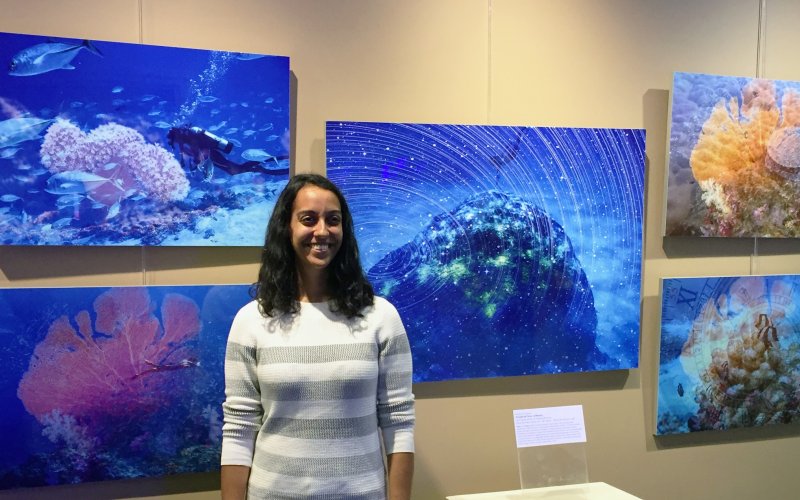Oceanographer Shares Her Research through Artistic Expression

ALBANY, N.Y. (July 22, 2021) – What happens when science intersects with art?
Sujata Murty, an assistant professor in the Department of Atmospheric and Environmental Sciences (DAES), is among a group of 10 scientists who worked with artists over the last year as part of SYNERGY II. The collaborative project between Art League RI (ALRI) and the Woods Hole Oceanographic Institution (WHOI) offers a unique opportunity to share ocean science research through artistic expression.
Murty’s research examines past changes in ocean and climate systems through the collection of coral samples. Just as growth rings offer clues into climate changes occurring during the lifespan of a tree, coral reefs have long histories to tell. Oceanographers, like Murty, dive into the ocean and drill cores from massive boulder corals, taking care not to harm the corals. These cores provide scientists with important information about past climate conditions, along with insight for future climate modeling.
Through SYNERGY II, Murty was paired up with Marcy Cohen, a photographer based in New York City. The pair worked remotely on a photo series called “Oceans of Time,” which highlights different elements of Murty’s past dives in the Indonesian Seas and Pacific Ocean. The five pieces were on display and available for purchase during a month-long exhibition “SYNGERGY II: Below the Surface” at the Falmouth Art Center in Massachusetts.

“Before I decided to pursue an ocean science career, I wanted to be an opera singer, and actually spent my last three years of high school at the Interlochen Center for the Arts,” said Murty, who joined DAES as a new full-time faculty member last semester. “Once I realized that my love for music was more of a hobby than a career, I started to look for ways to integrate the arts into my research interests.”
“The SNYERGY II project allows me to merge two of my greatest passions together, reaching new and larger groups of people who might otherwise not be able to connect with scientists in a meaningful way.”
Although they have yet to meet in person, Murty enjoyed working with Cohen, and plans to continue to build on their artist-scientist relationship. In the future, she would also like to incorporate musical elements into her research through collaborations with a choir or dance company.
Marcy Cohen focuses her photographic work on the “collision of past, present and future,” as a way to explore what it is like to “be alive at this moment in time and where we might be going.” She felt an instant connection to Murty and her work.
“Art and science generally operate in separate silos,” Cohen said. “We believe creating more synergy between art and science will instill greater understanding allowing scientists to reach broader audiences and instill wide-ranging intellectual and emotional connections to their work.”
Murty, who is also an adjunct scientist at the Woods Hole Oceanographic Institution, co-authored a review paper published this week in Nature Reviews Earth & Environment that explores heat and freshwater changes in the Indian Ocean region over the last half century.
You can learn more about her research on the DAES website and more about Cohen’s photography at www.marcycohen.com.




